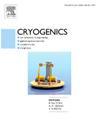Influence of Ba substitution on phase formation, RBS analysis, critical current density and flux pinning dynamics in Y-BSCCO superconducting materials
IF 2.1
3区 工程技术
Q3 PHYSICS, APPLIED
引用次数: 0
Abstract
The structural, morphological and magnetic for Bi1.8Y0.2Sr2-xBaxCa2Cu3O10, (x = 0.0, 0.05, 0.1, and 0.15), superconductors were investigated. SEM and elemental mapping showed a layered morphology with interconnected grains, with no detected unknown elements which confirmed throughout Rutherford Backscattering (RBS) spectra. The structural parameters and volume fractions were calculated from XRD. Magnetic measurements reveal the formation of the Bi-2212 phase instead of the intended Bi-2223, with transition temperatures () around 89–90 K. BiYBa0.15 shows the highest critical current density , reaching approximately 800 A/m2 at 10 K and 9.2 A/ m2 at 40 K, while BiYBa0 and BiYBa0.05 show ≈1.45 A/m2 at 60 K. Temperature-dependent magnetization measurements performed at 10 K, 40 K, and 60 K under applied fields up to 60 kOe demonstrate complex pinning force dynamics. Notably, the pure and x = 0.15 samples exhibit enhanced pinning forces at low temperatures, while intermediate Ba concentrations show modified flux pinning landscapes. The achieved high make these materials are promising candidates for wires, tapes, and superconducting fault current limiters.

Ba取代对Y-BSCCO超导材料相形成、RBS分析、临界电流密度和磁通钉钉动力学的影响
研究了Bi1.8Y0.2Sr2-xBaxCa2Cu3O10 (x = 0.0, 0.05, 0.1和0.15)超导体的结构、形态和磁性。扫描电镜和元素图显示了层状结构,颗粒相互连接,未检测到未知元素,这在整个卢瑟福后向散射(RBS)光谱中得到了证实。用XRD计算了结构参数和体积分数。磁测量显示形成了Bi-2212相,而不是预期的Bi-2223相,转变温度(Tc)在89 - 90k左右。BiYBa0.15表现出最高的临界电流密度Jc,在10 K和40 K时分别达到约800 A/m2和9.2 A/m2,而BiYBa0和BiYBa0.05在60 K时的临界电流密度Jc≈1.45 A/m2。在10 K、40 K和60 K下,在高达60 kOe的磁场下进行的温度相关磁化测量显示出复杂的钉钉力动态。值得注意的是,纯样品和x = 0.15样品在低温下表现出增强的钉钉力,而中等Ba浓度的样品则表现出改变的通量钉钉景观。获得的高Jc使这些材料成为电线,磁带和超导故障电流限制器的有希望的候选者。
本文章由计算机程序翻译,如有差异,请以英文原文为准。
求助全文
约1分钟内获得全文
求助全文
来源期刊

Cryogenics
物理-热力学
CiteScore
3.80
自引率
9.50%
发文量
0
审稿时长
2.1 months
期刊介绍:
Cryogenics is the world''s leading journal focusing on all aspects of cryoengineering and cryogenics. Papers published in Cryogenics cover a wide variety of subjects in low temperature engineering and research. Among the areas covered are:
- Applications of superconductivity: magnets, electronics, devices
- Superconductors and their properties
- Properties of materials: metals, alloys, composites, polymers, insulations
- New applications of cryogenic technology to processes, devices, machinery
- Refrigeration and liquefaction technology
- Thermodynamics
- Fluid properties and fluid mechanics
- Heat transfer
- Thermometry and measurement science
- Cryogenics in medicine
- Cryoelectronics
 求助内容:
求助内容: 应助结果提醒方式:
应助结果提醒方式:


